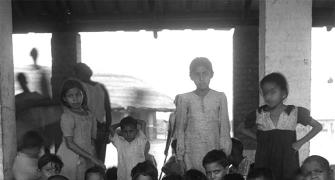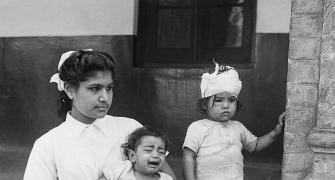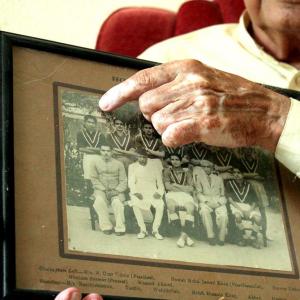There were Vedic mantras engraved along with prayer songs for Lord Shiva, Lord Rama and Lord Krishna.
Neither the government nor the people of Faisalabad demanded that the carvings be removed.
I felt very happy to see Sanskrit shlokas engraved on a monument in Faisalabad.
Around 500 metres away, there was a temple of Lord Shiva, which was intact and in its original form.
Nobody had demolished that temple, and a few metres ahead, there was a temple of Lord Rama...
An enchanting excerpt from Rajeev Shukla's Scars of 1947: Real Partition Stories.

Before he entered the worlds of politics and cricket administration, Rajeev Shukla was a well-known journalist at the erstwhile Sunday magazine and The Sunday Observer newspaper.
Now you must be thinking why I visited Faisalabad (Lyallpur). A family dear to me, Tiwari-Chibba, is based in Panchsheel Park in Delhi.
Tejendra Tiwari's mother, Champa Tiwari, hailed from Lyallpur and the family of Tejendra Tiwari's sister, Savita Chibba, lives with the Tiwaris under one roof.
Savita's daughter is Gauri, who is married to the famous Bollywood actor Shah Rukh Khan. Often, when I used to visit Shah Rukh Khan's in laws with him, I would meet Champa Tiwari, who was Gauri's maternal grandmother.
Gauri's family is now Shah Rukh's family and every time he visits Delhi, he stays with them and Gauri's family treats him as their own son.
Champa Tiwari used to talk to me about Pakistan often as I visited that country frequently.
What I could sense was that though she was based in Delhi, her heart still resided in Lyallpur.
I observed that she was happiest when narrating stories related to Lyallpur. She even requested me to take her to Lyallpur.
She wanted to see her house, her school, her city and her village, but her children did not want her to travel so far at her age.
Champa Tiwari's husband was Rai Bahadur Sardar Thakar Singh, a Mohyal Brahmin (Mohyal Brahmins are a section of Indian Brahmins with origins in the Punjab region).
Thakar Singh's father, Sardar Jawahar Singh, was in the Bengal Lancers division of the British army.
The family owned a lot of land. They had huge tracts of land in Lyallpur too and, moreover, their village was also named after Thakar Singh.
Champa used to live in the village adjacent to the city, and her house in the city was in the Vakilaa di Gali (Lawyer's Lane) locality, which was close to the Lyallpur clock tower, situated in the middle of the city.
Champa was married to a resident of Lahore, Somdutt Tiwari, who had completed his studies from Government College, Lahore.
The Tiwari family shifted to Punjab from Banaras hundreds of years ago and was very rich.
They also owned many acres of land in Toba Tek Singh province, Kartarpur and Himachal Pradesh as well.
After Partition, they were given 150 acres of land each in Anandpur Sahib and Banga against the properties that they held in Pakistan.
They had a huge farmhouse in Kartarpur near Jalandhar where they settled after Partition and already owned land in Himachal.
Later, Champa Tiwari shifted to Delhi with her son Tejendra and daughter Savita.
She passed away in 2018 at the age of 98; during Partition, she must have been around 27.
Maybe that is why she remembered each and every moment of her life in Lyallpur.
Though the city had been renamed Faisalabad long ago, she still used to call it Lyallpur.
I thought that since Champaji herself could not visit Lyallpur, I could at least get her something from there to refresh her memories attached with that place.
When I went to Lahore next, I planned a visit to Lyallpur and informed the deputy commissioner of that place about my arrival. He happened to organize a lunch at the residence of the largest textile mill owner there.
When I reached Faisalabad, I got in touch with Champa Tiwari over the phone. First, I decided to visit her college and school -- Queen Mary's College.
Its building was a very old structure that had not been reconstructed.
The school building was huge and looked quite grand. The college building was also as it had been long ago, and I clicked many photographs of the school and college.
After visiting these places, I made my way towards her house located in Vakilaa di gali.
The area was very crowded and full of mom-and-pop stores.
Vakilaa di gali was actually a lane that had many two- and three-storey houses, but the difference was that now the place had become very dirty, and naked electrical wires could be seen everywhere. Moreover, the houses had not been renovated.
Champa's house was such that it looked like the luxurious residence of a rich and wealthy family.
Looking at the design, arches and the balconies of the house, I felt that it was quite an exquisite structure.
I clicked photographs of that house as well.
Hardly 200 metres away, there was a clock tower crossing which was very busy and crowded.
Surprisingly, the new resident of their house had not bothered to get the house renovated or even giving it a fresh coat of paint.
In fact, the refugees who came from eastern Punjab were either allotted houses randomly or they themselves captured whichever house they found vacant.
The houses built and owned by the Hindus and the Sikhs were huge and luxurious, which poorer Muslims got an opportunity to capture.
However, they were financially incapable of taking care of these houses.
The rules that were framed read that the Muslims who came to Pakistan from India to reside permanently would be allotted houses according to the quality and area of properties held by them in India.
In short, a Muslim emigrant would be allotted a house to live according to the financial status that they held while they resided in India.
However, this rule was violated to a great extent.
People either bribed the officers or lied to them without producing sufficient documentation of the properties they had back in India.

A member of the Punjab legislative assembly at that time, Jahanara Shahnawaz, went on to write that there was so much fraud in the allotment of houses and plots that the most non-deserving people who migrated to Pakistan from India ended up living in huge bungalows, even though they did not even know how to turn on an electrical switch.
Later, the Muslims who were actually rich and had vast properties in pre-Partition India had to live in ordinary houses in Pakistan since the country had run out of appropriate accommodation for them.
The Hindus and the Sikhs had huge and luxurious bungalows in Lahore, Rawalpindi, Lyallpur, Jhelum, Gujranwala and Sialkot in Pakistan.
But their houses were captured by those who could not have even dreamed to have such houses earlier.
For them, Partition proved to be a blessing in disguise.
The fault lay with the officers, who were either careless or dishonest, at the rehabilitation department in Pakistan.
On the other hand, the officers on the Indian side of the border treated all the Hindu and Sikh refugees with respect and care.
After proper verification of documents and their financial status, the allotment of houses, plots and shops was done without any fraud and partiality.
The entire process was monitored by Pandit Jawaharlal Nehru, the first prime minister of India, who personally oversaw the entire matter of property distribution among the people who came from Pakistan.
Looking at Champa Tiwari's residence, I felt that all the houses in that locality were illegally occupied by those who could not otherwise afford them.
However, after visiting Champa's house, I came to the clock tower crossing.
Clock towers can be found in several small cities of India as well.
They are built in the middle of the cities and are tall, steeple-like structures that are very beautiful.
They have a clock fitted in them that rings every hour to let the people know the time.
If it is 12 o'clock, the clock rings twelve times, and if it is 10 o'clock, it rings ten times and so on.
This is how the people of the city come to know the time.
When I was there, I saw a lot of hustle and bustle at Lyallpur's clock-tower crossing. There were shops and stores all around.
But I was astonished to see that no changes had been made at all to the clock tower.
It was made with marble all around, with Sanskrit verses written on it.
There were Vedic mantras engraved on it along with the prayer songs for Lord Shiva, Lord Rama and Lord Krishna.
Neither the government nor the people of Faisalabad demanded that the carvings be removed.
I felt very happy to see Sanskrit shlokas engraved on a monument in Faisalabad.
Moving on, around 500 metres away, there was a temple of Lord Shiva, which was intact and in its original form.
Nobody had demolished that temple, and a few metres ahead, there was a temple of Lord Rama, again in its original form, the white dome of which was clearly visible from a distance.
The only difference was that there was nobody to worship at these temples and their doors were locked.
However, nobody was allowed to demolish these sacred structures.
The roads and localities which were named after Hindu gods and goddesses had not been renamed.
Only the city was renamed as Faisalabad. I also went to have a look at the railway station from where Champa Tiwari always boarded the train for Lahore.

The interesting part was that when I was standing at the clock tower crossing, I was talking to Champaji over the phone, and it was she who asked me if there was a Shiv temple ahead.
Then she asked me if the Ram Janki temple was still located at so-and-so place.
I followed her directions over the phone and described to her whatever I saw on the way.
Suddenly, she said that there was a kulfi vendor who would be stationed in a corner of the clock tower which she would visit frequently.
It was on the southern corner of the clock tower.
I looked around for the kulfi vendor for quite some time and finally spotted him!
I went to his shop to eat a kulfi and asked the owner, who was an aged Muslim man, 'How long have you been running this shop?' He replied that it had been more than eighty years that he had been selling kulfis there.
Excerpted from Scars of 1947: Real Partition Stories by Rajeev Shukla with kind permission of the author and Penguin India.
Feature Presentation: Aslam Hunani/Rediff.com








